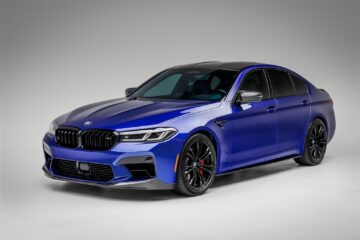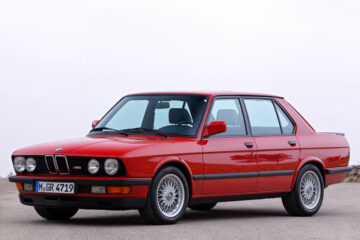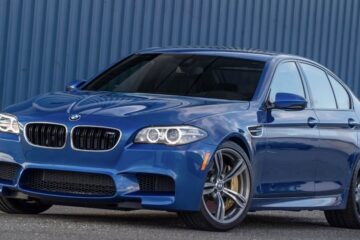The presentation of the sports sedan took place in 1998. Here is a photo of this BMW M5 E39. It took place at the auto show in Geneva. The third generation of sports cars was presented with only one body. The design of the M5 E39 has rounded off and its body is more powerful.
This car the Germans began assembling on the assembly line of the factory located in Dingolfing, replacing the old 1997 model. 540i . For 5 years of production, the concern produced 20,482 cars. There was also created a prototype BMW E39 M5 touring, but then the Germans decided not to produce a station wagon for financial reasons.
Appearance
The design of the car is similar to the standard E39 model. The differences of the BMW M5 in E39 body are as follows: radiator grille around is trimmed with chrome, M-Technic spoiler is installed and there is a transparent glass on the turn signals. Window openings are standard, but with chrome trim or covered with Shadowline gloss (black color).
Differences on the stern from the E39. Bumper complete with diffuser. The diffuser of the BMW M5 E39 includes pipes for the exhaust. There are four of them in two pairs. The option is a spoiler. It is installed on the trunk lid, and it has a body color.
Specially for the M5 E39 external electric mirrors have been developed. The exterior of the sports car is also decorated with a nameplate “M5”. If the buyer does not want it, it can be removed.
All BMW M5 E39s are equipped with R18 alloy wheels. The body has an aerodynamic drag of 0.31 Cx.
At the end of the exterior review, let’s talk about dimensions. In length, the sports sedan stretched to 4.78 meters. The width of the car is 1.8, height – 1.44 meters. Wheelbase of M5 E39 does not exceed 2.83 meters. Ground clearance of the car is 120 mm, weight is 1.72 tons.
Interior
Unlike the E39 production cars, the interior trim of the BMW M5 E39 was made of higher quality materials. There were wood trim and a variety of leather upholstery. On sedans intended for the North American market, in the “base” were already electric sunroof, on-board navigation, airbags (rear, side – September 2002) and parktronic. For European sport sedans, they were additional options.
The sport seats were heated and the lumbar support could be adjusted. The system memorized three positions. The upholstery was available in “Sport” or “Exclusive”/”Luxury” variants for the American car market. The steering wheel, which has three spokes, is covered with threads of three colors. There are buttons to control cruise control with audio system.
The dashboard of the BMW E39 M5 sports car received an aluminum frame and red arrows. The speedometer shows a speed limit of 300 km/h, and it is decorated with the “M” logo (it is also applied on the door sills and the handle of the gearbox lever). At the bottom of the tachometer you can see the engine oil temperature sensor, notice the signals on the LEDs, which are extinguished when the powertrain reaches operating temperature.
The sports car is also equipped with a footrest.
Versions and equipment
There were 3 versions of the BMW M5 iii E39 sports sedan.
10490 vehicles were produced for European markets. Of these 7895 were LHD (left hand drive) and 2595 were RHD. Sedans were produced for 4.5 years, from fall 1998 to summer 2003. The 9992 left-hand drive models were intended for the North American market. Production started in 1999 and stopped in 2003.
In cars for Europe and S. America, there were no particular differences in the description, if we exclude small mechanical differences. An example is the presence on “American” M5 E39 models of catalytic converters (differences in emission requirements) of exhaust gases on the power units.
Electronics
In this series, the vehicle was equipped with DSC (Dynamic Stability Control) for the first time. It included systems controlling directional stability (ASC) and traction control. A test drive of the BMW M5 E39 showed that they helped to correct chassis steerability.
Add to that the ABS system.
Technical specifications
Now let’s see what are the specifications of the BMW M5 E39.
The M5 E39 was powered by a 400-horsepower, atmospheric V-twin, eight-cylinder S62B50 unit with a displacement of 4.9 liters and an aluminum cylinder block. A dual-system air intake increased the power of the BMW M5 E39 motor. The throttle response was electronic and the unit itself was digitally controlled by Simmens’ MSS 52 Matronic.
The engine of the BMW M5 E39 was combined with a 6-speed “Getrag” MKPP.
The sports car could reach a hundred in 5.3 seconds. The top speed of the three-volume model reached 250 km/h (300 km/h without a limiter). Fuel consumption in the city/on the highway/mixed cycle is 21.2/9.8/13.9 liters.
The size of the fuel tank is 70 liters.
The car was equipped with two suspensions: front independent (MacPherson) on double wishbones and aft multi-lever suspension. The steering wheel had power steering. All chassis were equipped with disc brakes (front – also ventilated) with ABS system.
These are the characteristics of the BMW M5 E39.
Difference between restyling and prerestyling
In 2001, a restyling of the sports car took place. However, there were no serious mechanical changes after the update.
The 2003 BMW M5 E39 2003 BMW M5 E39 has been added to its equipment list:
- New optics (changed design);
- Park Distance Control. It was mounted on the front bumper;
- Three-spoke steering wheel;
- Sensor for climate control in auto mode;
- Navigation;
- Audio system with a 6.5-inch display;
- Rear airbags. They protect the heads of the passengers;
- Optional audio system with 2 subwoofers and special speakers.
Over the next two years, the DVD navigation system was updated and there was a new body paint job.
Additional changes to the BMW M5 E39 can be made with tuning.
In 2003, the M5 E39 rolled off the assembly line. It was replaced by the M5 E60 and M5 61 models.
Generations and configurations
3 generation
03.1998 – 07.2003
| 5.0 MT Base | S62B50 | 4.9L | 400 hp |



0 Comments